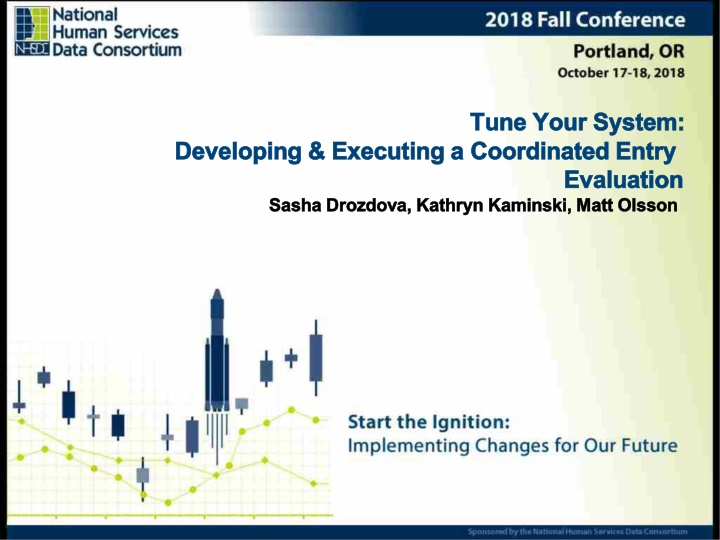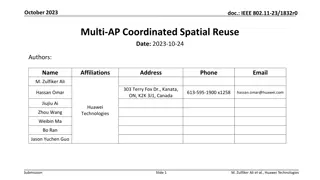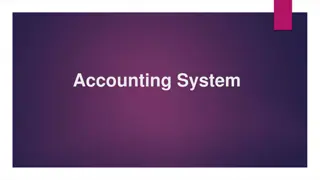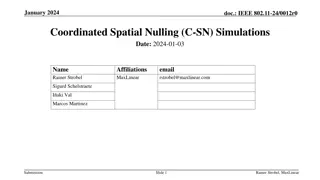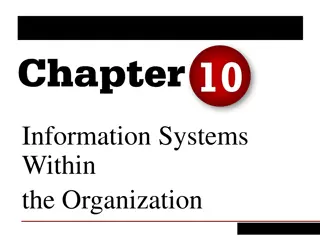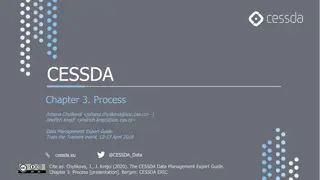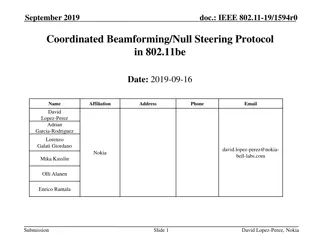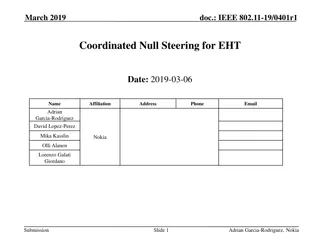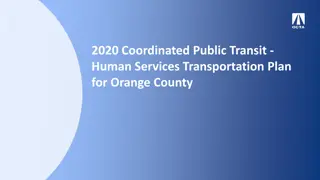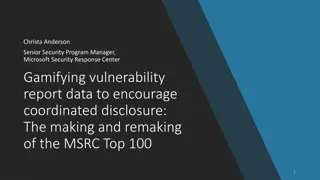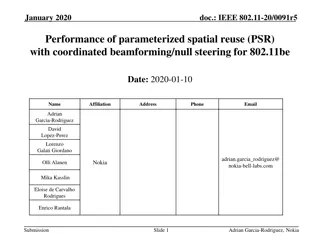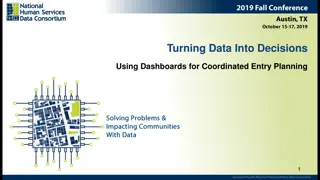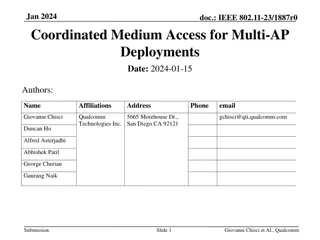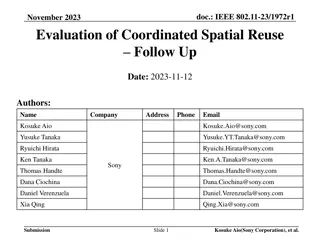Evaluating and Improving Coordinated Entry Systems
Community should regularly evaluate their coordinated entry systems to ensure proper functioning and identify necessary refinements for continuous improvement. Evaluation helps in maintaining effectiveness and efficiency of the system, benefiting all stakeholders involved in the process.
Download Presentation

Please find below an Image/Link to download the presentation.
The content on the website is provided AS IS for your information and personal use only. It may not be sold, licensed, or shared on other websites without obtaining consent from the author.If you encounter any issues during the download, it is possible that the publisher has removed the file from their server.
You are allowed to download the files provided on this website for personal or commercial use, subject to the condition that they are used lawfully. All files are the property of their respective owners.
The content on the website is provided AS IS for your information and personal use only. It may not be sold, licensed, or shared on other websites without obtaining consent from the author.
E N D
Presentation Transcript
Tune Your System: Tune Your System: Developing & Executing a Coordinated Entry Developing & Executing a Coordinated Entry Evaluation Evaluation Sasha Drozdova, Kathryn Kaminski, Matt Olsson Sasha Drozdova, Kathryn Kaminski, Matt Olsson
Tune Your System: Tune Your System: Developing & Executing a Coordinated Entry Developing & Executing a Coordinated Entry Evaluation Evaluation Sasha Drozdova, Kathryn Kaminski, Matt Sasha Drozdova, Kathryn Kaminski, Matt Olsson Olsson Why Evaluate Your Coordinated Entry Why Evaluate Your Coordinated Entry System? System? Your community should evaluate your coordinated entry system on an ongoing (at least annual) basis in order to:
Tune Your System: Tune Your System: Developing & Executing a Coordinated Entry Developing & Executing a Coordinated Entry Evaluation Evaluation Sasha Drozdova, Kathryn Kaminski, Matt Sasha Drozdova, Kathryn Kaminski, Matt Olsson Olsson Why Evaluate Your Coordinated Entry Why Evaluate Your Coordinated Entry System? System? Your community should evaluate your coordinated entry system on an ongoing (at least annual) basis in order to: Ensure Proper Functioning: Ensure Proper Functioning: Ensure that the coordinated entry system is functioning as intended and working for all stakeholders 1 1
Tune Your System: Tune Your System: Developing & Executing a Coordinated Entry Developing & Executing a Coordinated Entry Evaluation Evaluation Sasha Drozdova, Kathryn Kaminski, Matt Sasha Drozdova, Kathryn Kaminski, Matt Olsson Olsson Why Evaluate Your Coordinated Entry Why Evaluate Your Coordinated Entry System? System? Your community should evaluate your coordinated entry system on an ongoing (at least annual) basis in order to: Ensure Proper Functioning: Ensure Proper Functioning: Ensure that the coordinated entry system is functioning as intended and working for all stakeholders 1 1 Identify Necessary Refinements: Identify Necessary Refinements: Identify changes and improvements that will further support coordinated entry as an evolving practice 2 2
Tune Your System: Tune Your System: Developing & Executing a Coordinated Entry Developing & Executing a Coordinated Entry Evaluation Evaluation Sasha Drozdova, Kathryn Kaminski, Matt Sasha Drozdova, Kathryn Kaminski, Matt Olsson Olsson Why Evaluate Your Coordinated Entry Why Evaluate Your Coordinated Entry System? System? Your community should evaluate your coordinated entry system on an ongoing (at least annual) basis in order to: Ensure Proper Functioning: Ensure Proper Functioning: Ensure that the coordinated entry system is functioning as intended and working for all stakeholders 1 1 Identify Necessary Refinements: Identify Necessary Refinements: Identify changes and improvements that will further support coordinated entry as an evolving practice 2 2 HUD Requirement: HUD Requirement: Evaluation of your coordinated entry system is a HUD requirement 3 3
Tune Your System: Tune Your System: Developing & Executing a Coordinated Entry Developing & Executing a Coordinated Entry Evaluation Evaluation Sasha Drozdova, Kathryn Kaminski, Matt Sasha Drozdova, Kathryn Kaminski, Matt Olsson Olsson HUD Requirements HUD Requirements Through its Coordinated Entry Notice, HUD has imposed three requirements related to the evaluation of coordinated entry systems: Core Requirements: Core Requirements: The CoC must consult with each participating project and project participants at least annually to evaluate the intake, assessment, and referral processes associated with coordinated entry. Solicitations for feedback must address the quality and effectiveness of the entire coordinated entry experience for participating projects and households. [HUD Coordinated Entry Notice: Section II.B.15] Coordinated Entry Notice: Section II.B.15] [HUD
Tune Your System: Tune Your System: Developing & Executing a Coordinated Entry Developing & Executing a Coordinated Entry Evaluation Evaluation Sasha Drozdova, Kathryn Kaminski, Matt Sasha Drozdova, Kathryn Kaminski, Matt Olsson Olsson HUD Requirements HUD Requirements Through its Coordinated Entry Notice, HUD has imposed three requirements related to the evaluation of coordinated entry systems: Evaluation Methods: Evaluation Methods: The CoC must identify, through written coordinated entry policies and procedures, the frequency and method by which the evaluation will be conducted, including how project participants will be selected to provide feedback, and must describe a process by which the evaluation is used to implement updates to existing policies and procedures. [HUD Coordinated Entry Notice: Section II.B.15] Entry Notice: Section II.B.15] [HUD Coordinated
Tune Your System: Tune Your System: Developing & Executing a Coordinated Entry Developing & Executing a Coordinated Entry Evaluation Evaluation Sasha Drozdova, Kathryn Kaminski, Matt Sasha Drozdova, Kathryn Kaminski, Matt Olsson Olsson HUD Requirements HUD Requirements Through its Coordinated Entry Notice, HUD has imposed three requirements related to the evaluation of coordinated entry systems: Privacy Protections: Privacy Protections: The CoC must ensure that adequate privacy protections of all participant information collected in the course of the annual coordinated entry evaluation. [HUD Coordinated Entry Notice: Section II.B.12] Notice: Section II.B.12] [HUD Coordinated Entry
Tune Your System: Tune Your System: Developing & Executing a Coordinated Entry Developing & Executing a Coordinated Entry Evaluation Evaluation Sasha Drozdova, Kathryn Kaminski, Matt Sasha Drozdova, Kathryn Kaminski, Matt Olsson Olsson Additional HUD Guidance Additional HUD Guidance In addition, HUD has provided recommended guidance on conducting evaluations of coordinated entry systems, including: Incorporating system performance measures or other criteria into their required coordinated entry evaluation plan Ensuring that the evaluation is part of the implementation planning process from the inception of coordinated entry (e.g., which aspects of effectiveness are measured, which will be evaluated for fidelity to policies and procedures, how to gather data, whether/how to use the evaluation results to inform other aspects of system planning, etc.) Employing multiple feedback methodologies (e.g., participant surveys, small focus groups, individual interviews, etc.)
Tune Your System: Tune Your System: Developing & Executing a Coordinated Entry Developing & Executing a Coordinated Entry Evaluation Evaluation Sasha Drozdova, Kathryn Kaminski, Matt Sasha Drozdova, Kathryn Kaminski, Matt Olsson Olsson Phases of Coordinated Entry Evaluation Phases of Coordinated Entry Evaluation Developing Scope Selecting Methods Gathering Information Analyzing Results Calibrating the System
Tune Your System: Tune Your System: Developing & Executing a Coordinated Entry Developing & Executing a Coordinated Entry Evaluation Evaluation Sasha Drozdova, Kathryn Kaminski, Matt Sasha Drozdova, Kathryn Kaminski, Matt Olsson Olsson Developing Scope Developing Scope 1. Determine the extent of your evaluation Access? Assessment? Prioritization? Referral? All phases? 2. Present information & solicit feedback This is our mandate on X This is our goal on Y How are we doing? 3. Elicit challenges experienced by key players Where are you experiencing roadblocks and bottlenecks? 4. Discuss previous evaluation or any other relevant data collected so far & solicit input What, if anything, has changed?
Tune Your System: Tune Your System: Developing & Executing a Coordinated Entry Developing & Executing a Coordinated Entry Evaluation Evaluation Sasha Drozdova, Kathryn Kaminski, Matt Sasha Drozdova, Kathryn Kaminski, Matt Olsson Olsson The Santa Clara System The Santa Clara System
Tune Your System: Tune Your System: Developing & Executing a Coordinated Entry Developing & Executing a Coordinated Entry Evaluation Evaluation Sasha Drozdova, Kathryn Kaminski, Matt Sasha Drozdova, Kathryn Kaminski, Matt Olsson Olsson Prioritizing Values & Concerns Prioritizing Values & Concerns Ensuring Access Fair & equal access Consistency Client experience Diversion Privacy protection Accurate assessment Effective prioritization Assessment & Prioritization Match & Referral Timeline Rejected referrals
Tune Your System: Tune Your System: Developing & Executing a Coordinated Entry Developing & Executing a Coordinated Entry Evaluation Evaluation Sasha Drozdova, Kathryn Kaminski, Matt Sasha Drozdova, Kathryn Kaminski, Matt Olsson Olsson Developing a Data Collection Strategy Developing a Data Collection Strategy Interviews Focus groups Matchmakers Access point agencies Agencies receiving referrals Unhoused consumers Housed consumers Providers Surveys Data analysis Providers Consumers HMIS Other systems?
Tune Your System: Tune Your System: Developing & Executing a Coordinated Entry Developing & Executing a Coordinated Entry Evaluation Evaluation Sasha Drozdova, Kathryn Kaminski, Matt Sasha Drozdova, Kathryn Kaminski, Matt Olsson Olsson Questions for Matchmakers Questions for Matchmakers Internal Coordination Matchmaking Process Training Assessment Efficacy & Consistency Referral Process Referral Rejections
Tune Your System: Tune Your System: Developing & Executing a Coordinated Entry Developing & Executing a Coordinated Entry Evaluation Evaluation Sasha Drozdova, Kathryn Kaminski, Matt Sasha Drozdova, Kathryn Kaminski, Matt Olsson Olsson Questions for Providers Questions for Providers Accessibility & Client Experience Assessment Efficacy & Consistency Diversion Client Consent to Share Information Referral Process Enrollment Process
Tune Your System: Tune Your System: Developing & Executing a Coordinated Entry Developing & Executing a Coordinated Entry Evaluation Evaluation Sasha Drozdova, Kathryn Kaminski, Matt Sasha Drozdova, Kathryn Kaminski, Matt Olsson Olsson Questions for Consumers Questions for Consumers Accessibility & Assessment Messaging/ Marketing Connection to Services Referral to Housing
Tune Your System: Tune Your System: Developing & Executing a Coordinated Entry Developing & Executing a Coordinated Entry Evaluation Evaluation Sasha Drozdova, Kathryn Kaminski, Matt Sasha Drozdova, Kathryn Kaminski, Matt Data Analysis Data Analysis Olsson Olsson Ensuring Access Assessments: Where? When? Which? How many? Assessment vs. PIT Count demographics Where did consumers live when they lost their homes? Assessment & Prioritization Completeness & duplication of assessments Validity of & compliance with consents to share information Distribution of assessment scores Match & Referral Referral rates (cumulative & by acuity) Time from first assessment to first referral, to program enrollment, to housing move-in Referral rejections (by program type & by time on community queue) Reasons for referral rejections by program type
Tune Your System: Tune Your System: Developing & Executing a Coordinated Entry Developing & Executing a Coordinated Entry Evaluation Evaluation Sasha Drozdova, Kathryn Kaminski, Matt Sasha Drozdova, Kathryn Kaminski, Matt Olsson Olsson An Actionable Evaluation An Actionable Evaluation Keep your audience in mind Understand allocation of responsibilities among system players Elicit suggestions of training/tools/resources that would be helpful Identify discrete actions necessary to improve system Assign responsibility for making suggested improvements
Tune Your System: Tune Your System: Developing & Executing a Coordinated Entry Developing & Executing a Coordinated Entry Evaluation Evaluation Sasha Drozdova, Kathryn Kaminski, Matt Sasha Drozdova, Kathryn Kaminski, Matt Olsson Olsson Analyzing & Reporting Results Analyzing & Reporting Results Of providers surveyed, 42.9% reported conducting a second VI-SPDAT due to changed circumstances between 1-3 times within the last year, 26.2% between 4-10 times, and 31.0% reported doing so over 10 times.
Tune Your System: Tune Your System: Developing & Executing a Coordinated Entry Developing & Executing a Coordinated Entry Evaluation Evaluation Sasha Drozdova, Kathryn Kaminski, Matt Sasha Drozdova, Kathryn Kaminski, Matt Olsson Olsson Calibrating the System: Ensuring Access Calibrating the System: Ensuring Access Identify opportunities to advertise coordinated entry & publicize list of access points throughout community Draft policies & procedures on how non-VSPs should identify & serve DV survivors Develop informational materials for clients on what to expect after assessment & FAQ/myth-busting guidance for providers
Tune Your System: Tune Your System: Developing & Executing a Coordinated Entry Developing & Executing a Coordinated Entry Evaluation Evaluation Sasha Drozdova, Kathryn Kaminski, Matt Sasha Drozdova, Kathryn Kaminski, Matt Olsson Olsson Consistent, Accurate Messaging Consistent, Accurate Messaging The new client FAQ includes graphic illustrating the system & answers commonly asked questions: What is the VI-SPDAT survey and why did I take it? How is my information stored? / What is HMIS? What happens next? Is the Community Queue a waiting list? If I reported honestly about my past, will that hurt my chances for housing? Am I guaranteed to get housing through this process? What can I do after taking the VI-SPDAT survey?
Tune Your System: Tune Your System: Developing & Executing a Coordinated Entry Developing & Executing a Coordinated Entry Evaluation Evaluation Sasha Drozdova, Kathryn Kaminski, Matt Sasha Drozdova, Kathryn Kaminski, Matt Olsson Olsson Calibrating the System: Assessment & Prioritizat Calibrating the System: Assessment & Prioritizat Develop internal controls to ensure consistency in assessment administration & positive client experience Develop protocols regarding what changed circumstances warranting re-assessment entail Continue improving completeness of consents to share information through training & modifications to the form to address common issues
Tune Your System: Tune Your System: Developing & Executing a Coordinated Entry Developing & Executing a Coordinated Entry Evaluation Evaluation Sasha Drozdova, Kathryn Kaminski, Matt Sasha Drozdova, Kathryn Kaminski, Matt Olsson Olsson Clarified Re Clarified Re- -Assessment Policy Assessment Policy As long as individuals/families remain homeless, they should complete the VI- SPDAT annually to capture changes in their circumstances. In addition, individuals/households may complete an update whenever they experience a life event or change in circumstances that substantially impacts their vulnerability. This may include, but is not limited to, a significant change in: Amount of income or benefits, Health or disabling condition, Ability to care for oneself or dependents, Family composition, and/or Exposure to imminent danger or risk of severe physical harm.
Tune Your System: Tune Your System: Developing & Executing a Coordinated Entry Developing & Executing a Coordinated Entry Evaluation Evaluation Sasha Drozdova, Kathryn Kaminski, Matt Sasha Drozdova, Kathryn Kaminski, Matt Olsson Olsson Calibrating the System: Match & Referral Calibrating the System: Match & Referral Develop written protocols to train & support new matchmakers Create checklist of to enumerate expectations regarding reasonable attempts to locate referred clients Analyze causes of ineligible referrals & identify potential process modifications to reduce rates of referral rejection Modify HMIS interface to encourage updating client contact/location information
Tune Your System: Tune Your System: Developing & Executing a Coordinated Entry Developing & Executing a Coordinated Entry Evaluation Evaluation Sasha Drozdova, Kathryn Kaminski, Matt Sasha Drozdova, Kathryn Kaminski, Matt Olsson Olsson Consistent, Thorough Referral Search Strategy Consistent, Thorough Referral Search Strategy Consult other organizations/resources Go out in the community Check HMIS Create public alert Contact information Service contacts Profile notes VA County inmate locator tool for incarcerations & court dates Other outreach teams Law enforcement officials Medical social workers Visit homeless hotspots Meet people within the homeless community
Tune Your System: Tune Your System: Developing & Executing a Coordinated Entry Developing & Executing a Coordinated Entry Evaluation Evaluation Sasha Drozdova, Kathryn Kaminski, Matt Sasha Drozdova, Kathryn Kaminski, Matt Olsson Olsson Thank you! Thank you!
